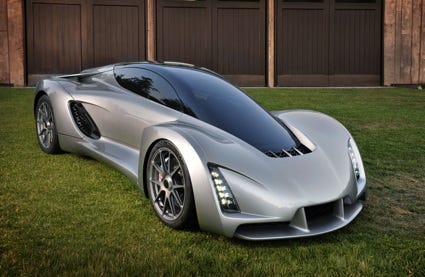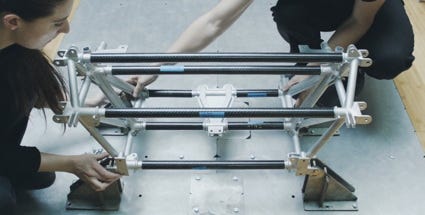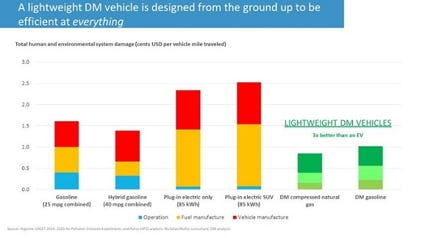A start-up based in San Francisco has unveiled what it describes as "a disruptive new approach to auto manufacturing that incorporates 3D printing to dramatically reduce the pollution, materials and capital costs associated with building automobiles and other large complex structures." Divergent Microfactories' approach is centered on direct metal laser sintering (DMLS) of aluminum "nodes" or joints that are used in combination with carbon-fiber-composite rods to form the vehicle chassis.
July 14, 2015
A start-up based in San Francisco has unveiled what it describes as "a disruptive new approach to auto manufacturing that incorporates 3D printing to dramatically reduce the pollution, materials and capital costs associated with building automobiles and other large complex structures." Divergent Microfactories' approach is centered on direct metal laser sintering (DMLS) of aluminum "nodes" or joints that are used in combination with carbon-fiber-composite rods to form the vehicle chassis.
|
The Blade boasts true supercar performance, accelerating from zero to 60 mph in around two seconds. |
|
The Blade's chassis was assembled in around 30 minutes and weighs in at 100 pounds. |
|
Divergent Microfactories' approach to car manufacture is reportedly more environmentally-friendly than building electric vehicles. |
The node-based chassis incorporates 69 aluminum joints (39 of which are identical). It weighs in at around 100 pounds (61 pounds of aluminum and 41 pounds of carbon fiber) versus over 1,000 pounds for a traditional chassis. The chassis was assembled manually in under half an hour (it could be assembled in about 15 minutes with a small robotic cell). A video of the process can be viewed here.
The chassis forms the basis of the company's first prototype, the Blade supercar boasting a power-to-weight ratio twice that of the Bugatti Veyron that was built with one-fiftieth the factory capital cost. To boot, the chassis is reportedly much stronger and more durable.
Divergent Microfactories envisages a potential production setup where node manufacture is centralized and microfactories are created for assembly. These would cost less than $5 million to set up compared with hundreds of millions of dollars for a traditional car assembly operation according to company founder & CEO Kevin Czinger. A fully outfitted micro-factory with in-house 3D printing capabilities, meanwhile, would have a startup cost of under $20 million and produce up to 10,000 cars a year.
Divergent Microfactories dubs its concept "Dematerialization and Democratization in Auto Manufacturing" and has outlined it in more detail in a white paper. One point this white paper emphasizes is that electric vehicles are not necessarily environmentally friendly if all manufacturing costs are taken into account. "Society has made great strides in its awareness and adoption of cleaner and greener cars. The problem is that while these cars do now exist, the actual manufacturing of them is anything but environmentally friendly," says Czinger.
The paper cites a 2009 report by the National Academy of Science, Hidden Costs of Energy: Unpriced Consequences of Energy Production and Use that compares the total human and environmental system damage for an 85-kWh electric SUV compared with similar plug-in electric, a hybrid gasoline vehicle, and a conventional gasoline car. Divergent Microfactories says its approach will be able to manufacture a gasoline-powered vehicle with a total system damage of around one cent per mile traveled versus cents per mile for the electric vehicle. A traditional gasoline-powered car comes in at about 1.5 cents per vehicle. The majority of the burden of the electric vehicle is derived from processes associated with the manufacture of the batteries.
"At Divergent Microfactories, we've found a way to make automobiles that holds the promise of radically reducing the resource use and pollution generated by manufacturing," says Czinger. "It also holds the promise of making large-scale car manufacturing affordable for small teams of innovators."
And as Blade proves, Czinger says that they've achieved it without sacrificing style or substance. Equipped with a 700-horsepower bi-fuel engine that can use either compressed natural gas or gasoline, Blade accelerates from 0-60 in about two seconds and weighs around 1,400 pounds. Divergent Microfactories plans to sell a limited number of high-performance vehicles that will be manufactured in its own microfactory.
You May Also Like





